Typical Pencil Grasp Development for Writing
Affiliate and Referral links are used below to promote products I love and recommend. I receive a commission on any purchases made through these links. Please see my disclosure policy for more details. As an Amazon Associate, I earn from qualifying purchases.
Proper pencil grasp development for writing starts a lot earlier than you think in children. From the time your child starts grasping for objects with their hands, they are developing a grasp.
If your child has ever received or been evaluated for Occupational Therapy, this is one thing that the therapist will be looking at when assessing their handwriting skills.
Before we get started, here are some term definitions that will help explain some of the hand grasps:
- Radial – Thumb side of the hand
- Digital – Finger or pinkie side of the hand; can also mean digits, as in fingers
- Palmar – Palm side, or inside part of the hand
- Supinate – Palm facing up or forwards
- Pronate – Palm facing down or backward
Typical Pencil Grasp Development in Kids
Let's start at the beginning. Again, these are average age ranges; every child is different. If you do suspect your child is behind in their development, please talk to your pediatrician or consult with your local Occupational Therapist.
Crude Palmar Grasp – 3-5 Months Old
- By age 3.9 months, your baby should be able to grasp a rattle or other objects.
- By age 5.2 months, they reach for objects with their whole arm using a crude palmar grasp (grabbing at objects with the pinkie side, or palmar side, of their hand. The thumb is not being used at this time.
Palmar Grasp – 6 Months Old
Your child will start using their entire hand to grasp objects, including some thumb movement. This is called a Palmar Grasp.
Radial Palmar Grasp – 7 Months Old
They will begin to involve the thumb and all fingers while using more of the thumb side of their hand to grab objects or using a radial palmar grasp.
Raking Grasp – 8 Months Old
By 8 months, your child will start to use a raking-type grasp. This involves bending (or flexing) the fingers to bring objects into the hand and closer to them.
Radial Digital Grasp – 8-10 Months
Between 8-10 months old your child will start to perfect the pincer grasp using a Radial Digital Grasp & Inferior Pincer Grasp. A radial grasp refers to the fingers from the middle finger to the thumb doing the grasping. As pictured, the child tends to use the pads of their fingers to grasp instead of the tips.
Inferior Pincer & Pincer Grasp – 10 Months Old
By the age of 10.2 months, they should be able to use a thumb-finger grasp (pincer grasp). The difference between the Inferior Pincer Grasp and a regular Pincer grasp is all in the placement of the fingertips.
The index and thumb are used for this grasp. If the pads of the fingers are holding the object, that is an Inferior Pincer Grasp. A true pincer grasp uses the tips of the pointer finger and thumb.
You may also see this referred to as the “Pincher” grasp; however, the correct spelling is “Pincer”.
Palmar Supinate Grasp – 12-15 months old
At this age, a young toddler begins to use a palmar supinate grasp. It is a fisted grasp with the thumb wrapped at the top of the writing utensil. This is usually accompanied by scribbling. This is considered a primitive grasp.
Digital Pronate Grasp – 2-3 Years Old
By 2-3 years old, a child moves to a digital pronate grasp, pictured below. This is the beginning of an efficient-looking hand grasp. The fingers are now pointed down towards the bottom of the writing utensil; however, all the fingers are being used along with a lot of whole arm movements. This is also a common grasp for self-feeding with utensils.
Static Tripod and/or Quadrupod Grasp – 3-4 Years Old
By age 3 to 4, a child will switch to a static tripod grasp or quadrupod grasp. They hold the writing utensils crudely and use the whole pads of their fingers on the writing utensil. There also may still be some wrist and forearm movement to move the pencil, with the fingers not moving, or static.
The static tripod grasp is a 3 finger grasp, two fingers pinching the writing utensil and the 3rd (middle) finger tucked to the side of the pencil, forming a tripod. The 4th and 5th fingers are usually static next to these fingers and do not tuck into the palm of the hand.
A quadrupod grasp is also referred to as a 4-finger grasp, with 3 fingers being on the pencil and then tucked on the 4th finger. It can also be static or dynamic. Dynamic is pictured below.
Dynamic Tripod Grasp – 5-6 Years Old
By the time your child hits kindergarten, they will use the most mature grasp, the dynamic tripod/quadruped grasp. They will use the tips of their fingers on the writing utensil and also hold the crayon/pencil more at an angle than vertically. This is much like an adult grasp.
Their finger movements are also dynamic, which means they move back in forth without any forearm or minimal wrist movement (the arm will be resting on the table or writing surface instead of floating above). This grasp is also referred to as a 3-finger grasp, with the first 2 fingers on the pencil while resting on the middle finger. The 4th and 5th fingers are tucked into the palm of the hand and help to stabilize the hand on the table.
Again, these are average age ranges, and every child is different. This does give you a good idea of what to look for as your child starts to explore the wonderful world of writing.
Hand Grasp Development Reference Cards
If you would like to have printable cards of all these hand grasps, complete with descriptions and photos, you can check out my hand grasp development cards here.
There is a digital and printed version available. They are great to have on hand in your classroom as you evaluate students. Or in your home or therapy sessions as a handy resource and reminder.
References
“From Rattles to Writing – A Parent's Guide to Hand Skills” – Barbara Smith, MS, OTR/L
“The Handwriting Book” – Functional Skills for Kids Pediatric Therapist Team
“Pencil Grip – A Descriptive Model and Four Empirical Studies.” – Ann-Sofie Selin, Master's in Special Education.
“The Fine Motor Olympics Manual” – Marcia P. Bridgeman
You May Also Like:

Heather Greutman, COTA
Heather Greutman is a Certified Occupational Therapy Assistant with experience in school-based OT services for preschool through high school. She uses her background to share child development tips, tools, and strategies for parents, educators, and therapists. She is the author of many ebooks including The Basics of Fine Motor Skills, and Basics of Pre-Writing Skills, and co-author of Sensory Processing Explained: A Handbook for Parents and Educators.

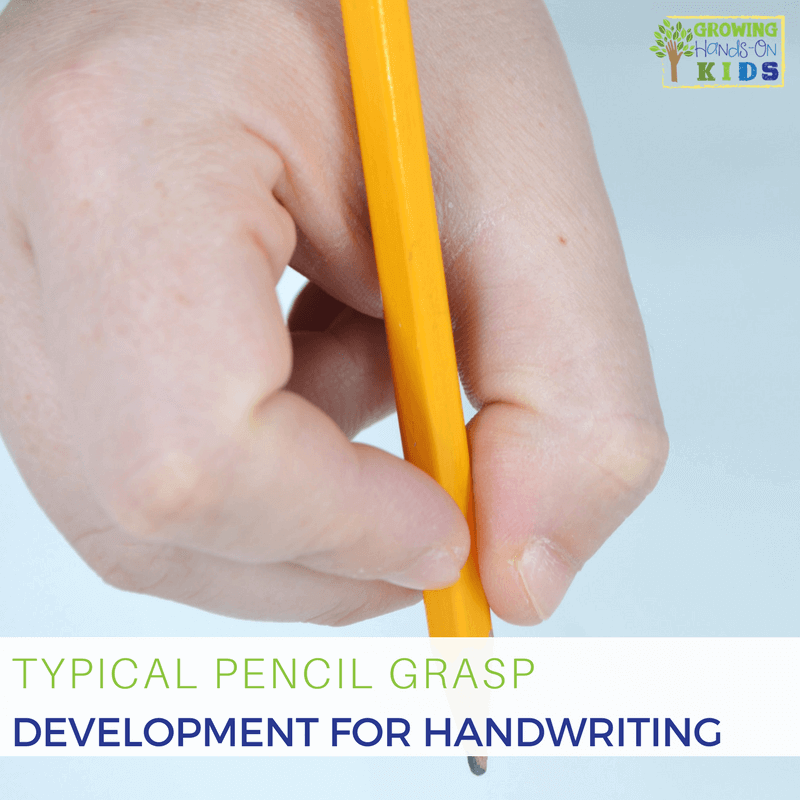
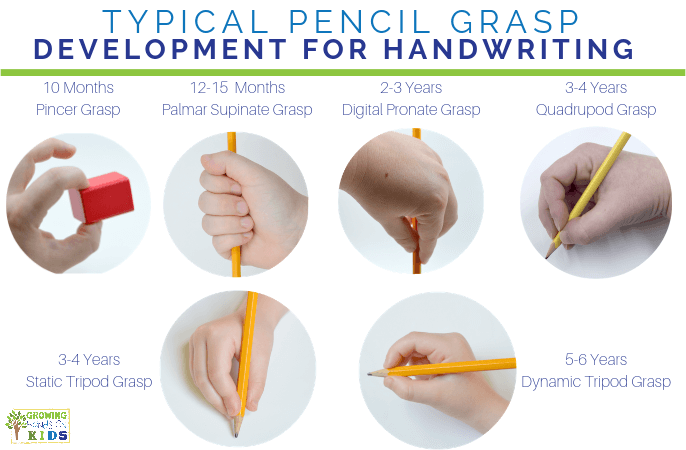
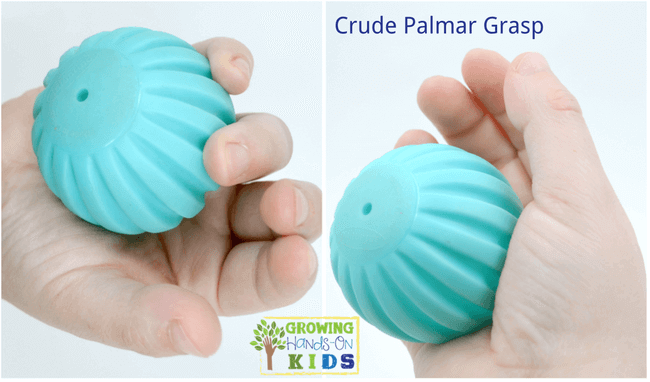
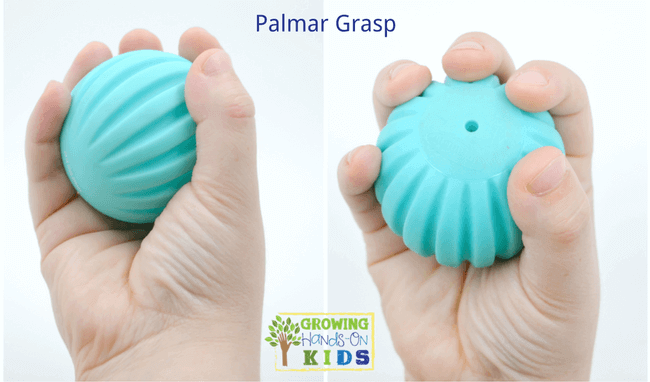
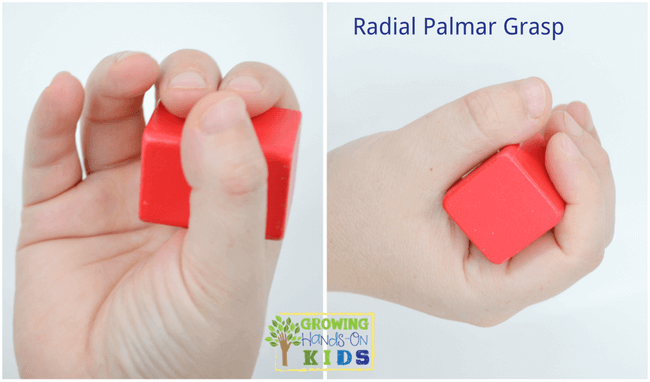
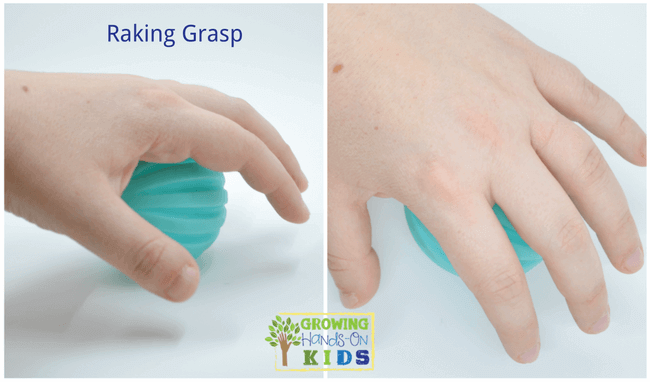
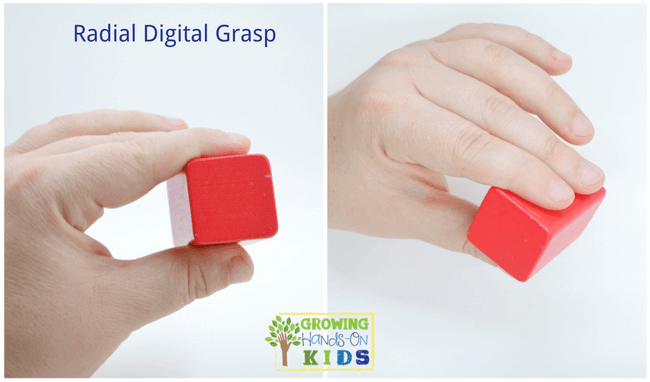
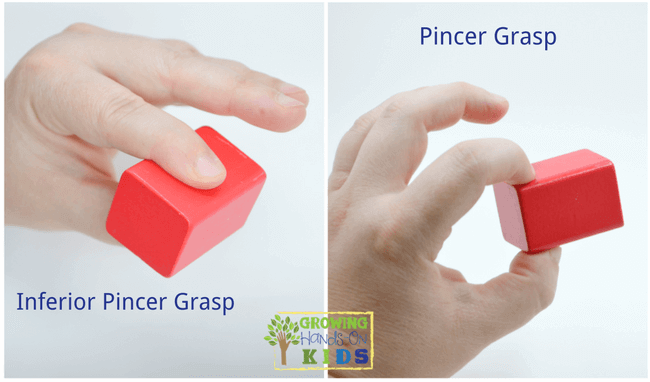
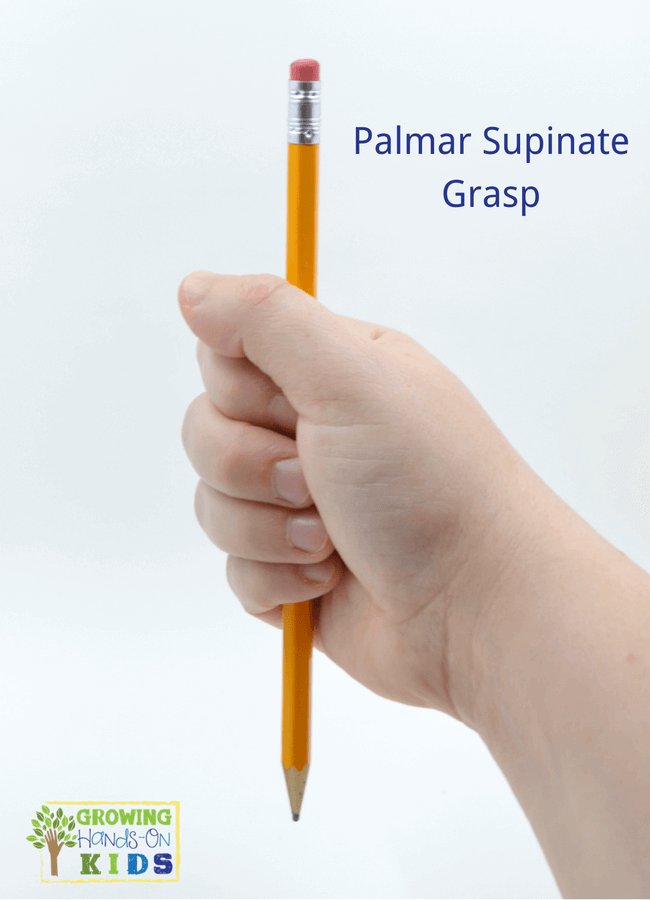
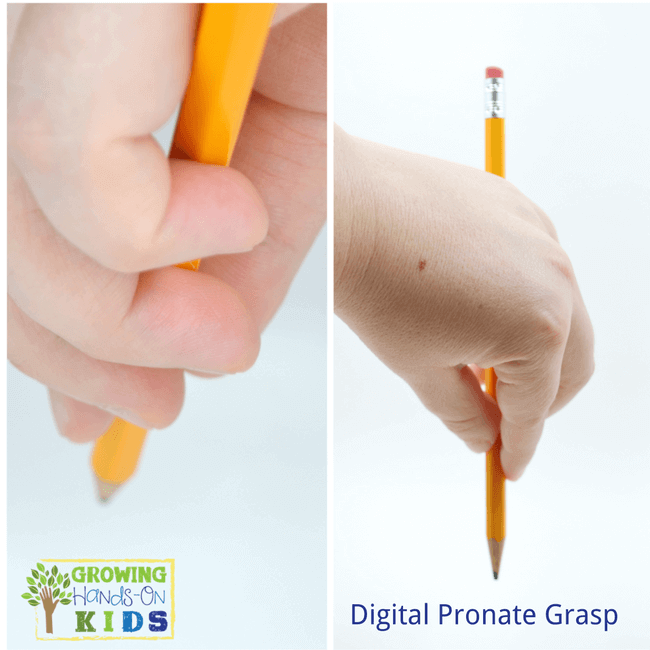
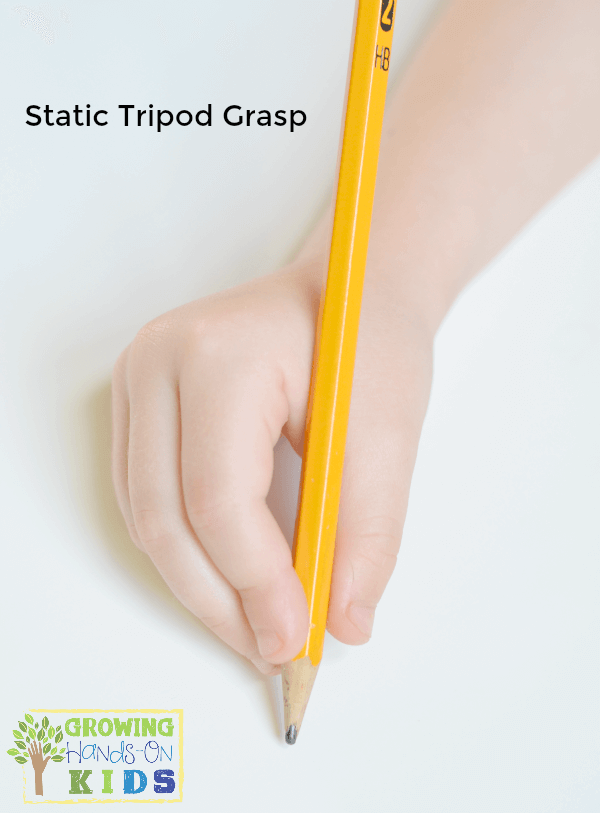
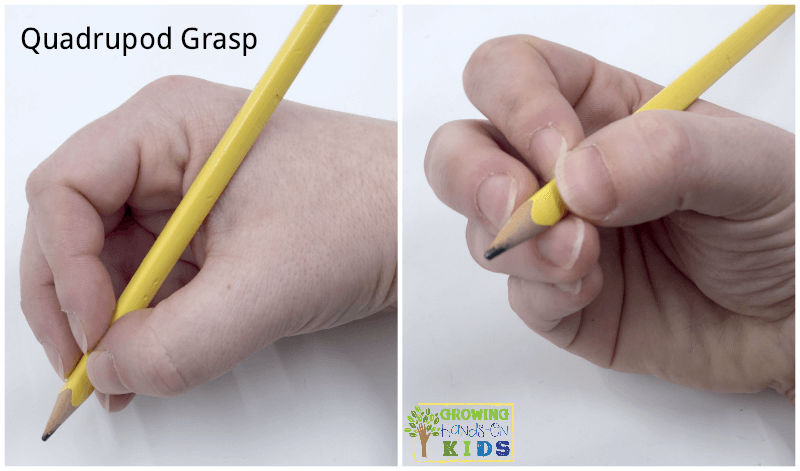
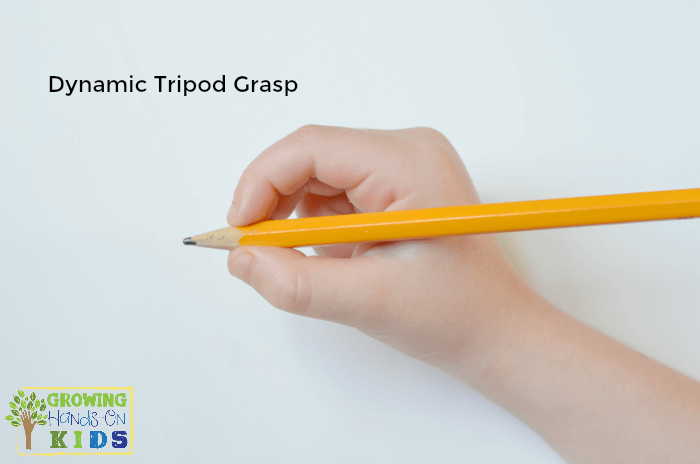
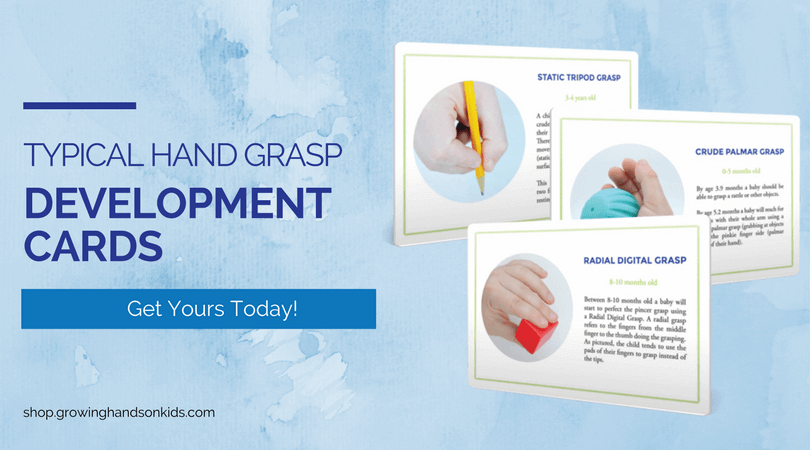
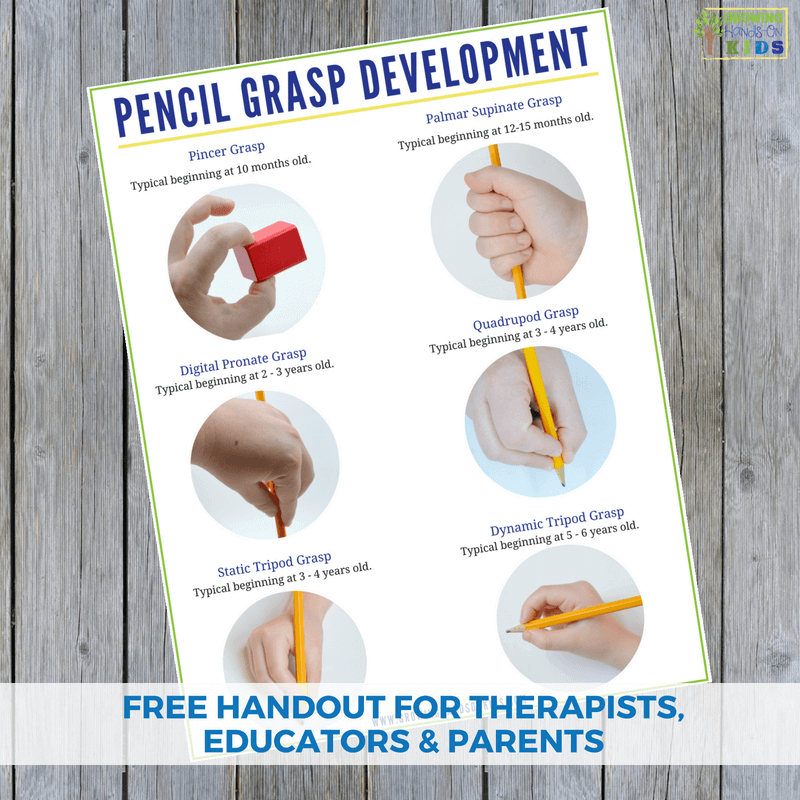

I am loving all of your articles. Do you have printables versions of your various pages?
Very helpful and informative. Thank you
Hi, Heather. I love this write up about grasps. I am doing a presentation for my school and would like to use a picture you have of the grasps. I will be referencing your website for more information. Thank you.
As a lefty mama with a son who has a 20%+ chance of being a lefty as well (it’s common on my mom’s side of the family!), will lefty children’s hands look mirrored or possibly a little different?
I have yet to find enough materials for lefty people!
And yes, my son is 2 1/4 years old and favors the left a lot more than right unless he tires of using left then switches. We have quite a few naturally ambidextrous family members (mostly men) so he’s getting a lot of that coming down the family trees!
I would like to know the source of this information so I can give a reference when I suggest it to my school
Hi Jana, I’ve included the resources at the bottom of the post, but you may not have seen them there. Here they are for your reference:
“From Rattles to Writing – A Parent’s Guide to Hand Skills” – Barbara Smith, MS, OTR/L
“The Handwriting Book” – Functional Skills for Kids Pediatric Therapist Team
“Pencil Grip – A Descriptive Model and Four Empirical Studies.” – Ann-Sofie Selin, Masters in special education.
“The Fine Motor Olympics Manual” – Marcia P. Bridgeman
hi. how about the tripod grasp where the thumb wraps around or rests on the index finger?
Hi! Any type of thumb wrap is considered an “inefficient” grasp, at least that is how OTs would mark it on an evaluation. As far as functionally, it really just depends on how the child’s legibility and speed are impacted by a different type of grasp. There is a lot of debate in the therapy world for whether or not pencil grasp does affect those two things or not. So if there is a different type of grasp, then I would look at their handwriting speed and legibility and then hand/finger strength to make sure nothing else is going on that would need to be addressed in their handwriting. Sometimes, a thumb wrap can mean they are holding the pencil too tightly and can cause pain in the hand or fingers during handwriting. OTs would also look at that when doing an initial eval, which then I would base my treatment strategies on (since I am an assistant).
My daughter wants to keep wrapping her index finger around the pencil instead of pinching it. She gets mad when I correct her grasp. My son has it down now that he’s finished first grade. He’s got a picture perfect pencil grasp.
I keep reminding myself that I have a terrible pencil grasp and in the 90s my teachers didn’t care and never said a word about it. All they cared about is if I did the work neatly. I rest my pencil on my fourth finger and use three fingers wrapped around the pencil lol. And yet here I am in my 30s trying to get my kids to use the pencil the proper way when I secretly still write “weird”, but neatly. I’m not going to give up correcting my daughter’s pencil grasp yet.
Just hoping to give parents hope that your kids will still turn out alright and will finish college just fine lol.
You have great photo’s of grasps. But the question is …Is it a quadrupod grasp? or as you referred to it as a quadruped grasp? Don’t mean to be technical but my OT coworkers and I have this ongoing discussion. We also call it a static tripod whenever only 3 fingers are involved even if the index and middle fingers are on the superior side.
Also what do you think of this grip? BUSHIBU Children Pen Writing Aid Grip
A few parents are raving about it.
Thanks for your questions and comment!
If it is a 3-finger grasp (thumb and index on the pencil and resting on the middle finger), then yes, I would consider that a static tripod. The quadrupod grasp would be a 4-finger grasp (thumb, index, and middle finger on the pencil and resting on the 4th finger). Not sure if that helps any, but at least in my mind and based on the research I have done those are the differences. As with everything, I’m sure there are differing opinions on it.
I am not familiar with the pencil grip you mentioned and have not used it so I’m afraid I can’t speak to it.
Your last photo supposedly shows a “4 finger”
or quadrupod grasp from the palm side, but ring finger is not near the pencil. Also, it would be helpful to review the “index” grip, which forces all movement to originate at the wrist. This is like a palmar supinate grasp in terms of rotation, but the pencil is held by all fingertips opposing the thumb (with a open web space and no contact with the palm).I have a lot of kids with this grip. It must be changed to allow distal control.
My 13 year old daughter had a good pencil grasp until last year, when suddenly she started holding the pen between her 3rd and 4th fingers, saying it is much more comfortable and less tiring. She writes fast and neat but it drives me mad seeing her write!!!!! what can I do? I would appreciate if someone could help me….it is so difficult to convince a 13 year old!!!!!
Thank you for this article. Found it most interesting and helpful.
Hi Heather, thank you very much for the knowledge. The information is very useful. Request permission to use the information for my sharing.
Hi Noorizam, Thanks! Feel free to share the link to this post with anyone.
Pls help with the grip of my child …he is 10 yeras old…and the way he holds the pencilis not perfect…i am too much worried…pls help me out if possible…TIA
Hi Kinnari, I am not really able to help with specific cases due to licensure law and my OTA license. However, I will say that age 10 is going to be hard to change a grasp because the habits have already been formed and it will be very hard to break. It also depends on if it is affecting his legibility or not with handwriting. If you have concerns, I would talk to your child’s physician or ask for an Occupational Therapy evaluation.
hi heather, loved your write up on pencil grasp. good read 🙂
can i please borrow a few of your pictures for my presentation on fine motor skill development
regards and thanks in anticipation
sharada
Hi Sharada,
Yes, you may use two (2) pictures as long as they are not edited in any way and you reference this post as the source. Thanks for asking and good luck with your presentation.
I love the pictures – because I would have no idea what the terms meant otherwise! 😉
Thank you for the specific details here, matched up with the developmental levels. It’s tempting to push kids with things like pencil grasp, so this is a good reminder of what can be reasonably expected.
Renae
Thanks for this!
Fantastic post! So informative, thank you! We’re working on this at home, so perfect timing for us. Thank you for sharing. Pinned.
Thank you for stopping by and pinning!
Haha, Hey Crystal! Thanks for coming by! Sounds like you are doing great with your little ones for handwriting. Yes, every child develops different. But if you try and force it too early that is NO fun for anyone!
Yep, I’m another who never got past the quadroped grasp! I didn’t know it ever wasn’t acceptable…lol. Although I do remember that teachers tried to change it, that’s just always what was most comfortable for me. I can hold my pencil and write the correct way, but it feels better and is faster the other way. I didn’t push things with my oldest and he was a little late with the pencil grasp, but then he got it just fine. I am being patient about it with my 4 year old as well 🙂 Thanks for sharing!
Great post. I hadn’t heard that the quadruped grasp was now considered an acceptable grasp. I have one son who has been quite insistent on this grip despite my best efforts.
I love the pictures the the timeline you provided for development.
Yes, Heather, on the Peabody Fine Motor Test I believe it is scored just slightly lower, but is considered within norms now. All of the OTs I worked with considered it an acceptable grasp as well. Which is good since I use that type of grasp myself, haha! 😉 Thanks so much for coming by and reading, it means a lot to me!
Hi Heather,
Thank you for interesting article.
My daughter is 18months and consistently uses tripod grasp in her right hand. How unusual is this and do you know if it is indicative of anything else in her development?
Kind regards
Leyla